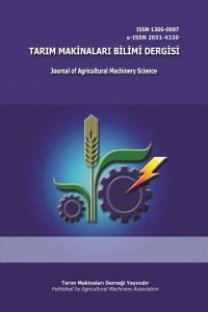A Continuous Leaf Monitoring System for Precision Irrigation Management in Orchard Crops
Leaf temperature, crop water stress index, cwsi, irrigation scheduling, continuous measurement, wireless mesh network, plant water status, almonds, walnuts
___
- Boyer, J.S. 1967. Leaf water potentials measured with a pressure chamber. Plant Physiol. 42(1):133-137 Coates, R. W., M. Delwiche, A. Broad, M. Holler, R. Evans, L. Oki, and L. Dodge. 2012. Wireless sensor network for precision irrigation control in horticultural crops. An ASABE meeting presentation, Paper No: 121337892, St. Joseph, MI. 49085.
- Dhillon R., V. Udompetaikul, F. Rojo, J. Roach, S. Upadhyaya, D. Slaughter, B. Lampinen, and K. Shackel. 2013. Detection of plant water stress using leaf temperature and microclimatic measurements in almond, walnut and grape crops. Trans. ASABE 57(1).
- Idso, S., R. Jackson, P. Pinter, R. Reginato, and J. Hatfield. 1981. Normalizing the stress-degree-day parameter for environmental variability. Agricultural Meteorology. 24:45-55.
- Jones, H. G. 2004. Irrigation scheduling: advantages and pitfalls of plant-based methods. J. Exp. Bot. 55(407):2427-2436.
- Lampinen, B., K. Shackel, S. Southwick, and W. Olson. 2001. Deficit irrigation strategies using midday stem water potential in prune. Irrig. Sci. 20(2):47-54.
- Nielsen, D. 1994. Non water-stressed baselines for sunflowers. Agricultural Water Management. 26(4) 265-276.
- Testi, L., Goldhamer, D., Iniesta, F., and M. Salinas 2008. Crop water stress index is a sensitive indicator in pistachio trees. Irrig. Sci. 26(5):395-405.
- Torman, H. 1986. Canopy temperature as a plant water stress indicator for nectarines. S. Afr. J. Plant Soil. 3(3): 110-114.
- Udompetaikul, V. (2012). Development of a sensor suite for plant water status determination for irrigation management in specialty crops. PhD diss. Davis, Cal.: University of California, Department of Biological Systems Engineering.
- USGS, 2005. Total Water Use in the United States. 2005.
- United States Geological Survey. Restron, Virginia. Yazar, A., T. Howell, D. Dusek, and K. Copeland. 1999.
- Evaluation of crop water stress index for LEPA irrigated corn. Irrig. Sci. 18: 171-180.
- ISSN: 1306-0007
- Yayın Aralığı: 4
- Başlangıç: 2005
- Yayıncı: Tarım Makinaları Derneği
Ömer Barış ÖZLÜOYMAK, Emin GÜZEL
Determination the Effect of a Vacuum Cleaning System on the Quality of Wheat Harvesting in Combines
Numerical Determination of Mulching Effect on Soil Temperature Distribution in Adana, Turkey
Arif ÖZBEK, Tuncay YILMAZ, Alper YILMAZ, Orhan BÜYÜKALACA
Costs Update of Olive Trunk Shaker Mechanical Systems
Effects of Drying Temperature and Final Grain Moisture Content of Paddy On Grain Cracks
Babak BEHESHTI, Ali SHAH MORADI, Maryam KARIMI MOTLAGH, Mohammad KAVEH
Characterization of Agricultural Machinery Blades
Özge ACARBAŞ BALTACI, Savaş YAPICI, İlhan DEMİRBAŞ, Serhan AKTAR, Gürsoy ARSLAN
Design, Analysis and Optimization of a Shock Absorber
Durmuş Ali BİRCAN, Abdulkadir YAŞAR
A Continuous Leaf Monitoring System for Precision Irrigation Management in Orchard Crops
Rajveer DHILLON, Francisco ROJO, Jed ROACH, Shrini UPADHYAYA, Mike DELWICHE
